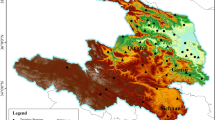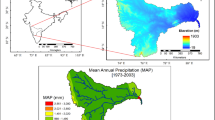Abstract
Future projections of climate variables are the key for the development of mitigation and adaptation strategy to changing climate. However, such projections are often subjected to large uncertainties which make implementation of climate change strategies on water resources system a challenging job. Major uncertainty sources are General Circulation models (GCMs), post-processing and climate heterogeneity based on catchment characteristics (e.g. scares data and high-altitude). Here we presents the comparisons between different GCMs, statistical downscaling and bias correction approaches and finally climate projections, with the integration of gridded and converted (monthly to daily) data for a high-altitude, scarcely-gauged Jhelum River basin, Pakistan. Current study relies on climate projections obtained from factorial combination of 5-GCMs, 2 statistical downscaling and 2 bias correction methods. In addition, we applied bias corrected APHRODITE, converted daily data using MODAWEC model and observed data. Further, five GCMs (CGCM3, HadCM3, CCSM3, ECHAM5 and CSIRO-MK3.5) were tested to scrutinize two suitable GCMs integrated with Statistical Downscaling Model (SDSM) and Smooth Support Vector Machine (SSVM). Results illustrate that the CGCM3 and HadCM3 were suitable GCMs for selected study basin. Both downscaling techniques are able to simulate precipitation, however, SSVM performed slightly better than SDSM. We found that the integration of CGCM3 with SSVM (SSVM-CGCM3) generates precipitation and temperature better than the CGCM3 (SDSM-CGCM3) and HadCM3 (SDSM-HadCM3) with SDSM. Furthermore, the low elevation stations were influenced by monsoon, significantly prone to rise in precipitation and temperature, while high-altitude stations were influenced by westerlies circulations, less prone to climate change. The projections indicated rise in basin-wide annual precipitation by 25.51, 36.76 and 45.52 mm and temperature by 0.64, 1.47 and 2.79 °C, during 2030s, 2060s and 2090s, respectively. The methods and results of this study can be adopted to evaluate climate change implications in the catchments of characteristics similar to Jhelum River basin.






Similar content being viewed by others
References
Addor N, Rössler O, Köplin N, Huss M, Weingartner R, Seibert J (2014) Robust changes and sources of uncertainty in the projected hydrological regimes of Swiss catchments. Water Resour Res 50:7541–7562
Azmat M, Choi M, Kim T-W, Liaqat UW (2016) Hydrological modeling to simulate streamflow under changing climate in a scarcely gauged cryosphere catchment. Environ Earth Sci 75:1–16. https://doi.org/10.1007/s12665-015-5059-2
Azmat M, Liaqat UW, Qamar MU, Awan UK (2017) Impacts of changing climate and snow cover on the flow regime of Jhelum River, western Himalayas. Reg Environ Chang 17:1–13. https://doi.org/10.1007/s10113-016-1072-6
Chen H, Xu C-Y, Guo S (2012) Comparison and evaluation of multiple GCMs, statistical downscaling and hydrological models in the study of climate change impacts on runoff. J Hydrol 434:36–45. https://doi.org/10.1016/j.jhydrol.2012.02.040
Dibike YB, Coulibaly P (2005) Hydrologic impact of climate change in the Saguenay watershed: comparison of downscaling methods and hydrologic models. J Hydrol 307:145–163. https://doi.org/10.1016/j.jhydrol.2004.10.012
Hagemann S, Chen C, Clark DB, Folwell S, Gosling SN, Haddeland I, Hanasaki N, Heinke J, Ludwig F, Voss F, Wiltshire AJ (2013) Climate change impact on available water resources obtained using multiple global climate and hydrology models. Earth Syst Dynam 4:129–144. https://doi.org/10.5194/esd-4-129-2013
Huang J, Zhang J, Zhang Z, Xu C, Wang B, Yao J (2011) Estimation of future precipitation change in the Yangtze River basin by using statistical downscaling method. Stoch Env Res Risk A 25:781–792
Kumar R, Singh S, Kumar R, Singh A, Bhardwaj A, Sam L, Randhawa SS, Gupta A (2016) Development of a Glacio-hydrological model for discharge and mass balance reconstruction. Water Resour Manag 30:3475–3492
Lee Y-J, Mangasarian OL (2001) SSVM: a smooth support vector machine for classification. Comput Optim Appl 20:5–22. https://doi.org/10.1023/A:1011215321374
Lin G-F, Chang M-J, Wang C-F (2017) A novel spatiotemporal statistical downscaling method for hourly rainfall Water Resour Manag 31:1–25. https://doi.org/10.1007/s11269-017-1679-5
Liu J, Williams JR, Wang X, Yang H (2009) Using MODAWEC to generate daily weather data for the EPIC model. Environ Model Softw 24:655–664
Lutz A, Immerzeel W, Kraaijenbrink P (2014) Griddedmeteorological datasets and hydrological modelling in the Upper Indus Basin (Costerweg 1V, 6702 AA Wageningen, The Netherlands)
Meenu R, Rehana S, Mujumdar P (2013) Assessment of hydrologic impacts of climate change in Tunga–Bhadra river basin, India with HEC-HMS and SDSM. Hydrol Process 27:1572–1589. https://doi.org/10.1002/hyp.9220
Najafi R, Kermani MRH (2017) Uncertainty modeling of statistical downscaling to assess climate change impacts on temperature and precipitation. Water Resour Manag 31:1843–1858
Richardson CW (1981) Stochastic simulation of daily precipitation, temperature, and solar radiation. Water Resour Res 17:182–190
Teutschbein C, Seibert J (2012) Bias correction of regional climate model simulations for hydrological climate-change impact studies: review and evaluation of different methods. J Hydrol 456:12–29
Vapnik VN (1998) Statistical learning theory vol 1. Wiley, New York
Wang X, Huang G, Lin Q, Nie X, Cheng G, Fan Y, Li Z, Yao Y, Suo M (2013) A stepwise cluster analysis approach for downscaled climate projection–a Canadian case study. Environ Model Softw 49:141–151
Wilby RL, Dawson CW (2013) The statistical downscaling model: insights from one decade of application. Int J Climatol 33:1707–1719
Wilby RL, Dawson CW, Barrow EM (2002) SDSM—a decision support tool for the assessment of regional climate change impacts. Environ Model Softw 17:145–157. https://doi.org/10.1016/S1364-8152(01)00060-3
Yatagai A, Kamiguchi K, Arakawa O, Hamada A, Yasutomi N, Kitoh A (2012) APHRODITE: constructing a long-term daily gridded precipitation dataset for Asia based on a dense network of rain gauges. Bull Am Meteorol Soc 93:1401–1415. https://doi.org/10.1175/BAMS-D-11-00122.1
Acknowledgements
The authors would like to special thanks Higher Education Commission of Pakistan for providing financial support under National Research Program for Universities (NRPU) (grant number NRPU#6003) and Start-up Research Grant Program (SRGP) (grant number: SRGP #1239).
Author information
Authors and Affiliations
Corresponding author
Ethics declarations
Conflict of Interest
The authors declare that they have no conflict of interest.
Electronic Supplementary Material
ESM 1
(PDF 895 kb)
Rights and permissions
About this article
Cite this article
Azmat, M., Qamar, M.U., Ahmed, S. et al. Ensembling Downscaling Techniques and Multiple GCMs to Improve Climate Change Predictions in Cryosphere Scarcely-Gauged Catchment. Water Resour Manage 32, 3155–3174 (2018). https://doi.org/10.1007/s11269-018-1982-9
Received:
Accepted:
Published:
Issue Date:
DOI: https://doi.org/10.1007/s11269-018-1982-9




